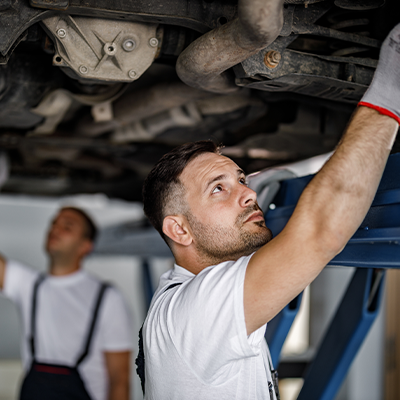- Home
- Services
- Suspensions
- Stabilizer rubber sleeve replacement
Stabilizer rubber sleeve replacement

The anti-roll bar is a flexible component which connects the left and right wheel suspension together. It transfers the force generated during the compression of the suspension on one side of the car to the opposite side to prevent it from tilting to one side too much. It is attached to the suspension by means of rubber bushes fitted on link rods. The bushes damp the vibrations coming from the suspension and reduce the noise generated by the bar. In the event of their failure the anti-roll bar loses support and rigidity.
Tips
- The rubber bushes should always be replaced in pairs
- Replacing the bushes requires replacing also their braces and mounting bolts
- If worn, the bushes produce a clatter when you drive over an uneven surface
Scope of services
- Removing the mounting bolts
- Removing the rubber bushes
- Fitting new bushes in
- Fitting new braces and bolts in
Find a car workshop
Check out our workshops that offer the service stabilizer rubber sleeve replacement in some of the biggest cities in your country
Additional info about the service
**What role does the anti-roll bar play?
The anti-roll bar is a rotating, flexible component, which connects together the suspension elements of the right and left wheel of the same axle of a car. It transmits the suspension lean from one side of the car to the other while turning. This way, it prevents the body from tilting too much and provides the wheel on the outer side of a curve with a better grip.
Where are the anti-roll bar bushings located?
The anti-roll bar is connected to the suspension by means of rubber bushings placed inside metal brackets. The anti-roll bar ends are attached to the the suspension elements by means of connecting rods. The rubber bushings holding the bar damp the vibrations coming from the suspension and the noise produced by the bar itself. When damaged, the bushings produce an annoying clatter and affect the operation of the anti-roll bar as they no longer provide it with sufficient support.
How is an anti-roll bar bushing replaced?
Replacing a bushing requires lifting the car. Next, the bolts holding the braces are removed, followed by the braces and bushings themselves. Frequently, corroded braces must be cut and re-threaded to be removed. If this is the case, the whole procedure takes longer than normally. New bushings are fitted in the reverse order.
Replacement of the bushings does not require wheel alignment.